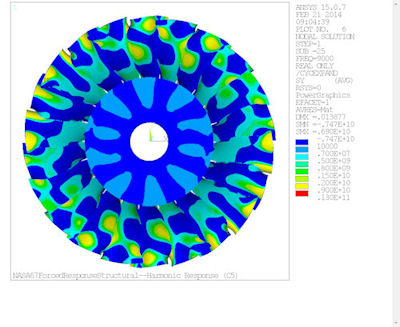Turbomachinery Blade Design
Reliable Turbomachinery Blade Design with Aeromechanical Simulation
Latest News
February 28, 2014
 Dear Desktop Engineering Reader:
Dear Desktop Engineering Reader:
I cannot blame my son, away at college, for being sick of me. I’ve turned into the old guy spouting aphorisms. See, every time I put some cash in his account, I hit him up with “a penny saved is a penny earned” or some such twaddle. That is a terrible lead-in to “at least he’s not engineering turbomachinery,” the subject of today’s Check it Out.
The tie-in I groped for here is that you people charged with designing, analyzing and optimizing turbomachinery are under great pressure from the honchos to squeeze out every bit of efficiency your design has in it. Your automotive, aerospace, power utility and similar clients demand greater efficiency because every—say ” 1% increase in fuel-burning efficiency can mean millions of dollars saved for them. And just to spice up things, you have to deal with all sorts of safety regulations and green initiatives.
Today’s Check it Out link takes you to a brand-new—some 24 hours live by the time you read this—ANSYS Fluid Dynamics Technology Tip called “Reliable Turbomachinery Blade Development with Aeromechanical Simulation.” We’re talking about vibration and flutter challenges here.
 |
The resources on the landing page include two articles, a pair of on-demand webinars and a video demo. The articles do not require registration to access. The webinars do require registration. But the heart of this tip, if you’re pressed for time right now, is a 6-minute, 30-second video from which the entire page gets its title. It’s smack in the middle of the page. We’ll focus on it in a minute.
The thing to know as you approach this page is that ANSYS has developed new high-fidelity simulation techniques for aeromechanics studies. The outline of the techniques is that you can couple the ANSYS Mechanical finite element analysis (FEA) tool with ANSYS CFX computational fluid dynamics (CFD) transformation methods for transient blade row analysis. Using this multiple physics coupling workflow, you can consider the aerodynamics and mechanics of a blade row simultaneously.
Some of the workflow features ANSYS provides are automated 3D hexahedral blade row (rotor as well as stator) meshing, CFD simulations to determine performance indicators like total pressure ratio and isentropic efficiency along an entire speed line, and transient blade row models to simulate transient full 360 blade phenomena (by only simulating a limited sector of the system). All blade natural frequencies and modes of vibration are aerodynamically damped, and the stresses caused by unsteady pressure fluctuations can be determined.
The video: It gives you a quick demonstration of the ANSYS simulation workflow for aeromechanics studies that covers all those workflow features. Specifically, you get a demo of an ANSYS CFD and structural simulation coupling predicting turbomachinery blade performance. The study subject is a NASA Stage 67 transonic fan.
The video is unnarrated, relying instead on pop-up captions and a music track that begins about 30 seconds in. It takes you through the simulation’s four major stages, beginning with geometry import. The second stage is rotor-only and stage CFD simulation to determine the steady state and stage performance of the rotor. Next there’s a blade flutter simulation to ensure that natural frequencies and vibrations are damped. Finally, there’s what’s called a “forced response” simulation, which helps determine stresses caused by unsteady pressure fluctuations on the blades.
The video shows you various reports, such as streamlined mapping and orbital plots. Many, many cool still and animated images illustrate what’s happening throughout the simulations. I recommend going into full-screen mode to better read the captions.
All in all, this video is mesmerizing. I suspect that if I were better versed in the nuances of how fluid flow and bladed components interact, I’d be blown away. Hit today’s link to see for yourself and see what I mean. Good stuff.
Thanks, Pal. – Lockwood
Anthony J. Lockwood
Editor at Large, Desktop Engineering
Reliable Turbomachinery Blade Design with Aeromechanical Simulation
Subscribe to our FREE magazine, FREE email newsletters or both!
Latest News
About the Author
Anthony J. Lockwood is Digital Engineering’s founding editor. He is now retired. Contact him via [email protected].
Follow DE





